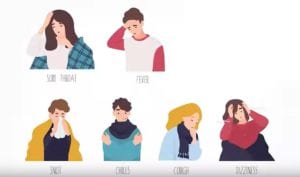
This time of year is notoriously known for sickness. This year, the news has been taken over by the spread of a disease named COVID-19, known more colloquially as the coronavirus. Despite holding the status of a super spreader, there are only 15 confirmed cases in the US with zero related deaths.
The coronavirus originated in Wuhan, China at the end of last year and has since resulted in the deaths of over 1660 people in China with over 68600 confirmed cases. These numbers are definitely scary, but in reality, the mortality rate is less than 0.02% – in some areas of the US, the death rate of the flu is greater than 20%.
The virus family which COVID-19 originates from, coronaviridae, is actually known for many diseases. For example, the SARS virus which spread in the early noughties was a form of coronaviridae. So, the coronavirus is not an entirely unknown issue.
In order to contract the coronavirus you have to actually come into contact with it either through contact with an infected person or a surface hosting which the disease has touched. Taking basic precautions, such as washing your hands or avoiding touching your nose or mouth can help you to protect yourself against getting sick, just like with any other generic illness.
According to ASAP Science, “Once the virus comes in contact with your cells it binds to receptors on that cell. You can think of the outer layer of the virus like a key and if the virus has found the right cells, in the right species, its keys are able to open the lock on these cells.” This means that the virus has access to start disrupting all the cell’s “machinery” and is able to start producing more viruses.
The immune response from your body is what creates the symptoms of illness which, according to the World Health Organization include: “serious respiratory illness with fever, cough, shortness of breath, and breathing difficulties.” The coronavirus often presents itself as pneumonia. These are common symptoms for a number of illnesses which in part is what has made the virus so tricky to track.
In the vast majority of cases the body and immune system is able to fight off the coronavirus, it is only in those with compromised immune systems (generally elderly people or the very young) who are at serious risk of death.
Being aware of the coronavirus is certainly important and it is well within reason to be concerned with its rapid spread. However, there are far greater health threats currently present in the United States. The most prominent at this time of year is the flu.
WLU Director of Student Health Services, Nurse Christy Bennington commented, “With communal living and so many students sharing classroom space, spreading colds and viruses is easy if you’re not careful.”
Paying extra attention to basic self-care habits such as hand washing, coughing into the bend of your arm, drinking lots of fluids and getting a flu shot is particularly important at this time of year. “If you have symptoms that aren’t showing any signs of clearing up within a few days, you may need to take a trip to Student Health Services or your doctor,” said Bennington. “Simple illnesses can sometimes turn into more dangerous ones if left alone so make sure to seek help if you aren’t feeling any better.”
Stay vigilant of the coronavirus and do not diminish its importance, but avoid undervaluing the threat of other more common, and potentially more dangerous, illnesses which are more potent in the US. Take care of yourself this flu season!









soundos • Mar 5, 2020 at 4:27 am
Great article, thanks for sharing.